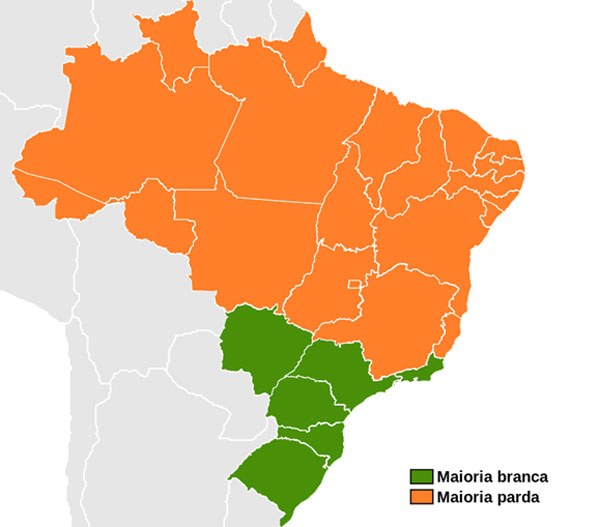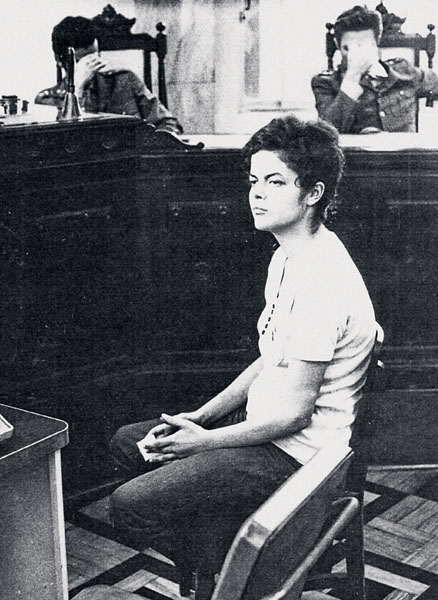Race in Brazil, Part II
R. Venturelli, American Renaissance, November 20, 2015
Part I described the history of immigration to Brazil, and the social and political currents that have led to today’s mixed-race population. This concluding section describes the intricate nature of race relations in Brazil today.
Contemporary Brazil
When civilians regained power in 1985, only the Left was well organized enough to take advantage of widespread dissatisfaction with the pro-American stance that had been taken by the military regime. The result has been an almost hegemonic power of the Left, which is symbolized by the current president, Dilma Rousseff, who led a terrorist organization that fought the military.
The Left slowly abandoned Marxism and now largely mimics the Democrat Party in the United States, with its broad coalition of “minorities,” promotion of “diversity,” and suspicion of heterosexual white men. What we see today is similar to the post-Tony Blair Labour Party in Britain and elsewhere in Europe. Despite an instinctively conservative electorate, the progressive Left manages to dominate the intelligentsia and the politics of Brazil.
The return to civilian rule led to a new constitution in 1988, which granted official protection to Indian reservations and quilombos. Many of those areas are rich in minerals, and this leads to frequent skirmishes with outsiders over development. The government has also introduced “affirmative action” for blacks, mulattoes, and Indians (but not Asians) in public universities and, more recently, for government jobs. Race, which had receded as an issue since the end of the policy of whitening Brazil, has become a problem. Blacks, who had quietly accepted a subservient status, have become much more demanding.

The many types of reservations take 34 percent of the land of Brazil. Brown: Land taken from unproductive owners and given to the poor as part of agrarian reform. Red: Quilombos. Pink: Indian Reservations. Green: Forest and jungle reserves.
Metamorphosis in race relations
In the last three decades, the percentages of the self-reported racial identities of Brazilians have changed as follows:
| Whites | Brown/Multiracial | Blacks | Asians | Indigenous | Undeclared | |
| 1980 | 54.23 | 38.85 | 5.92 | 0.56 | – | 0.44 |
| 1991 | 51.56 | 42.45 | 5.00 | 0.43 | 0.20 | 0.36 |
| 2000 | 53.74 | 38.45 | 6.21 | 0.45 | 0.43 | 0.71 |
| 2010 | 47.73 | 43.13 | 7.61 | 1.09 | 0.43 | 0.00 |
Since there has been very little immigration, the changes in percentages are largely a reflection of the perception of who is white, which is very fluid and has little to do with biology. Two factors determine who is considered white: social class and region.
In the Northeast, where there are many blacks and dark-skinned mulattoes, most middle-class light-skinned mulattoes consider themselves white. Thus, in the Northeast, the average “white” person has about 76 percent European genes. In the South, the average self-identified white has European ancestry approaching 90 percent, and anyone with black hair and dark eyes is suspect.[1] Thus, a person who considers himself white in the Northeast might consider himself a mulatto in the South.
Wealth can confer whiteness. Thus, both the people in the photographs below are very rich and consider themselves white. The soccer player Ronaldo Luís Nazário de Lima is from the North and Giselle Bündchen is from the South.

Ronaldo Luís Nazário de Lima and Giselle Bündchen
In a 2000 survey of people living in Rio de Janeiro who called themselves white, only 48 percent claimed to have pure European ancestry. The rest admitted to being various mixes of white, black and/or Indian.[2]
It is not unusual for mixed-race people to change their self-declared race over the course of their lives, especially if they have a big change in status. In the very rare cases in which a black or mostly-black person rises to upper-middle class or higher, the popular explanation is that he was a “black person with a white soul.”
In Brazil, self-identified white people — including light-skinned mulattoes — hold virtually all the political and economic power. In the middle and upper classes, whites may be openly against miscegenation, but a wealthy, light-skinned mulatto may be acceptable, especially outside the South.
Poor and lower-middle-class whites tend to be more race-blind, and sometimes even say race does not exist, but the many small skinhead and white power groups mostly come from the lower classes. They have their own bands, concerts, protests, and websites, and often clash with black power or anarchist street gangs. Ironically, a significant number of obviously mixed-race people are accepted in white power groups.
Probably the most fluid racial group is those who call themselves brown or multiracial. Most of them have some admixture of white, black and Indian. Their share of the population fluctuates greatly, since they may change how they identify themselves to the census several times during their lives.[3] For many, the last thing they want to be thought of is black. Someone with mostly-black parents but with lighter skin may call himself “brunette,” “olive skinned,” “tanned,” or even white. Most multiracial people associate blackness with failure and crime. If a mulatto is tempted to do something wrong, he may say “I am black, but not that black.”
Although the desire to be white has been a constant in Brazilian history, change may be coming. With the blessing of the government, movements to glorify black culture began to appear in the end of the 1990s, and identity politics have became the main strategy of the Left. The government gives money to non-profits promoting black pride, and even to music groups such as Raça Negra (Negro Race). These groups tell mulattoes and mostly-black people to “be truthful to your roots.” There is a magazine called Raça (Race) that promotes black culture and achievement, and tries to encourage mulattoes to think of themselves as black. Most of its employees and writers are either mixed-race or white.
As part of the widespread effort to try to make mulattoes proud of their blackness, schools have begun to follow the American lead in demonizing Europeans as inherently imperialistic, and playing up even the most trivial black accomplishments. Some even teach that the Egyptians were black. Race preferences for blacks in public universities and government jobs have caused outrage among whites but make it attractive to claim to be black.
As a typical affirmative-action gesture, former president Luiz Inácio da Silva appointed Judge Joaquim Barbosa as the first black Supreme Court judge. Nevertheless, black influence and power in society remain minimal, and the movement to make whites feel guilty has made very little headway.
Still, many mulattoes now call themselves black. As the number of pure blacks in Brazil outside of quilombos is very small, it is this shift in mentality that explains the sudden increase in the percentages of blacks and mulattoes and the decline of whites between the 2000 and 2010 censuses.
Asians are a special case. According to the 2010 census they account for only 1 percent of the population, and outside of São Paulo and Paraná states, they are almost invisible.[4] The overwhelmingly majority are from Japan, but there are a few Chinese and Koreans. They are seen as eternal outsiders no matter how many generations they have been in Brazil, and they tend to stay in their own communities. The rest of the population calls all Asians “Japs.”
Despite their insularity today, the early Japanese immigrants were mostly men, and were forced to mix with other races. By the third and fourth generation, 42 and 61 percent, respectively, were mixed.[5] Those with any vestige of Asian appearance are still seen as “Japs,” with the result that they are not entirely part of either the Brazilian or unmixed Japanese communities.
In 1989, the Japanese government tried to boost a flagging population by offering huge incentives for Brazilians of Japanese descent — including third-generation immigrants — to return to Japan. Over 300,000 went back. It was a disaster. The Brazilian-Japanese — especially the second- and third-generation mixed-race Japanese — made little effort to learn the language, did not assimilate, established ghettos, were bad workers, and committed a lot of crime. Intermarriage between Brazilian-Japanese and native Japanese was minimal.
Japanese storekeepers put on special music when Brazilians came in so as to alert the staff to possible shoplifters. Some even put up signs saying, “no Brazilians allowed.” The police, who had been unarmed, began to carry weapons, and hired Portuguese teachers to help fight Brazilian crime.[6] The Japanese government started paying Brazilians to go back to Brazil and sign an oath saying they would never return.[7] The number of Brazilians dropped from more than 300,000 in 2007 to fewer than 200,000 in 2012.
There are 534 Indian reservations in Brazil, but only 0.43 percent of the population calls itself Indian. Genetically, this is absurd. A 2015 study of autosomal DNA, which summarized 25 studies of 38 different Brazilian populations, concluded that the proportion of Amerindian genes in the Brazilian population is 17 percent. [8] European genes were 62 percent and African genes were 21 percent.
The number of Indians in the census is so low because only those who still maintain a tribal affiliation call themselves Indians. Most of them live on reservations. People with significant Indian ancestry tend to call themselves “brown” or mixed race in the census. Outside reservations, the influence of Indians is essentially zero, but they sometimes stage protests and even take violent action to expand their protected areas.
Separatist movements

In the orange states the majority calls itself mixed-race. In green states, the majority calls itself white.
Brazil is home to many different populations and cultures, but the main division is between lower Brazil, which is mostly white, and the upper part, which is heavily mixed. The map is a more or less accurate depiction, though the cultural divide crosses state borders. The North tends to vote for more leftist parties and the South for centrist ones.
Only the three southern-most states are actually majority white. The other three (Mato Grosso do Sul, São Paulo, and Rio de Janeiro) are doubtful because so many light-skinned mulattoes call themselves white.
The three “Deep South” states — Paraná, Santa Catarina, and Rio Grande do Sul — completely stand out from the rest of the country. They have a genuinely white population, a higher IQ, a lower murder rate, and architecture that is more interesting than the ad hoc buildings thrown up elsewhere. The Southern states are where one finds the majority of legal firearms, and include the only state, Rio Grande do Sul, where hunting is legal.
The three southern-most states also have the only significant separatist movement: Sul é Meu País (South is My Country.) It has respectable spokesmen who appear on radio and television in the region. They subtly allude to the South having a different racial and ethnic composition, but avoid outrage by saying that the reason for separation would be cultural.
The group is organizing a 2016 referendum on secession from Brazil to take place as part of municipal elections.[9] The federal government has not said how it would respond to a vote for independence, but it would probably try to prevent it. Many of the largest military bases are in the South, and the three white states are among the few that pay more in federal taxes than they receive in benefits. The secessionists claim a right to secede under international law.
Current crisis
Brazil is in the thick of several crises. There has been a huge corruption scandal involving the state-owned oil company, Petrobras. With high inflation, a very unfavorable exchange rate, and unemployment rising, President Rousseff has the lowest approval rating in the history of the country — only 8 percent — with 66 percent of voters in favor of impeachment.[10]
The country is also trying to figure out what to do with a huge influx of Haitians. When the tsunami hit Haiti in 2010, Brazil led the United Nations stabilization effort and ended up with an estimated 130,000 Haitian refugees — though the number is probably higher. Haitians, who have an average IQ of 67 [11], are mostly illiterate and practice voodoo. Many get refugee benefits, which the native population — many of whom feel economically vulnerable — deeply resent.
There is also white flight. Brazil has suffered from negative migration rates for decades, and the result is a severe brain drain, as the mostly European upper-middle class leaves for developed countries. The government pays its best students to study abroad. Many, especially those who come from disadvantaged backgrounds and who had never been outside Brazil, don’t go back. There are now many illegal immigrants from Brazil in the United States and Western Europe.
Brazilians do anything they can, including fraud, to show European ancestry in order to get European citizenship. A European passport is a ticket to life in Europe and is a “promotion” to European status. There is a seven-year backlog at the Italian embassy of Brazilians trying to get citizenship.[12]
The overall fertility rate in Brazil has been below the replacement rate for years, and now stands at 1.8 children per woman. Total fertility for whites is, of course, lower. Low fertility, combined with emigration, means the population is shrinking, which will put pressure on the welfare system. Even the leftist President Rousseff has cut benefits.
Our future?
While some say that the United States might in the future become “Brazil with nuclear weapons,” I think that is unlikely. Brazil is in the final stages of a once-majority-white society that has completely embraced multi-racialism, but Brazil is different from European-majority countries in two ways: It has high miscegenation rates and lacks an ethno-cultural identity. While there is some intermarriage in America and Western Europe, the rates are not nearly as high as in Brazil, where 43.13 percent of the population calls itself multiracial. In Brazil, except for the South, there is widespread acceptance that the concept of “Brazilian” covers a very mixed population. An independent South could go on to build a white nation with a coherent culture, but the rest of the Brazil is on course to become a giant failed state like Venezuela.
In Europe, there is still some inchoate sense of racial identity. There is no real effort to assimilate newcomers, and tensions are rising. When too many non-whites move in, Europeans move away. I believe Europeans will wake up to the threat of dispossession before it is too late. In the United States, when whites finally stop running away from non-whites, it could lead either to violent balkanization or peaceful secession.
On the other hand, if whites remain passive, the West will indeed become Brazil. This will mean decay at every level: constant class warfare, extreme income inequality, and organized crime that rivals the powers of the state. It will mean shocking levels of violence; Latin America has the world’s highest murder rates.[13] The state will severely restrict gun ownership among law-abiding citizens, but criminals will have plenty of weapons. Nor will turning into Brazil solve the problem of “racism.” Brazilians, mixed as they are, still stratify themselves into racial hierarchies.
Brazil must not be our future.
- https://journals.plos.org/plosone/article?id=10.1371/journal.pone.0017063 retrieved on September 3, 2015.
- Edward Eric Telles, “Racial Classification”, Race in Another America: the significance of skin color in Brazil, Princeton University Press, 2004, pages 81 to 84.
- https://www.theguardian.com/world/2011/nov/17/brazil-census-african-brazilians-majority retrieved on September 25th, 2015.
- https://www.japao100.com.br/arquivo/nipo-brasileiros-estao-mais-presentes/ retrieved on September 17, 2015.
- https://www.labeurb.unicamp.br/elb/asiaticas/japones.htm retrieved on September 17, 2015.
- https://www.bbc.com/portuguese/noticias/2015/06/150518_decassegui_violencia_et_lab retrieved on September 17, 2015.
- https://content.time.com/time/world/article/0,8599,1892469,00.html retrieved on September 17, 2015.
- https://onlinelibrary.wiley.com/doi/10.1002/ajhb.22714/abstract retrieved on September 3, 2015.
- https://www.timbonet.com.br/movimento-o-sul-e-o-meu-pais-lanca-oficialmente-plebiscito-para-separacao-do-sul/ retrieved on September 4, 2015.
- https://datafolha.folha.uol.com.br/opiniaopublica/2015/08/1665278-recorde-reprovacao-a-dilma-supera-pior-momento-de-collor.shtml retrieved on September 3, 2015.
- Richard Lynn & Tatu Vanhanen, IQ & Global Inequality, Washington Summit Publishers, 2006, appendix 1.
- https://www1.folha.uol.com.br/fsp/cotidian/ff2710200908.htm retrieved on September 4, 2015.
- https://www.insightcrime.org/news-briefs/americas-replaces-africa-as-most-violent-region-in-world-un retrieved on September 4, 2015.
















